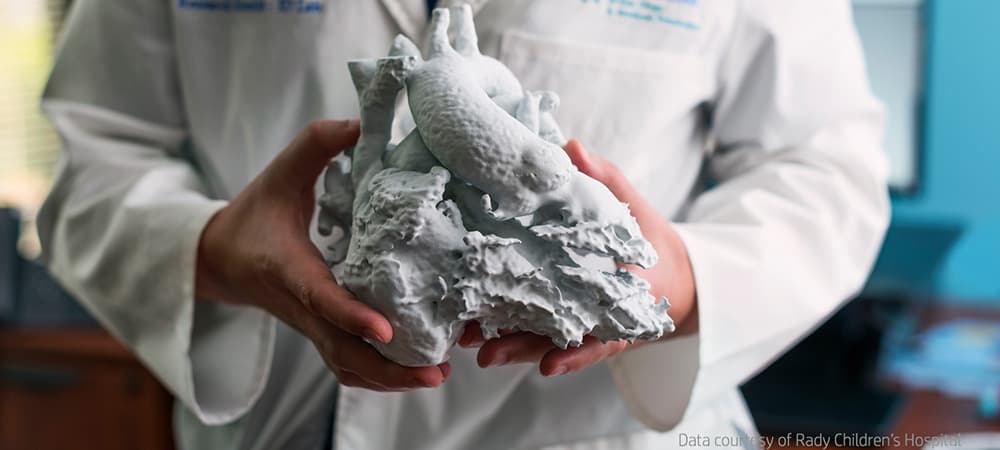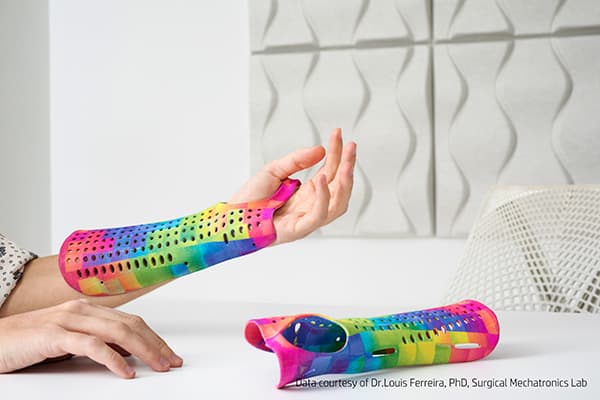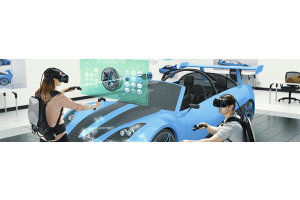We use cookies to offer you a better experience. For more information on how we use cookies you can read our Cookie and Privacy Policy.
The 10 Strangest 3D-Printed Objects (so far)

Here’s a riddle for you: What’s more amazing: Technology? Or what can be made with technology?
Apply that riddle to any number of topics: medicine, the internet, nuclear armament, or engineering, and you’re in for an afternoon of philosophical pondering. But, as far as 3D printing is concerned, there’s a very clear answer to the riddle.
While 3D printing technology is amazing, the things that have been created using 3D printing are far more incredible. Let’s discuss the 10 strangest things that have been 3D-printed. But first, let’s briefly review what has been going on in the 3D printing world.
How does 3D printing work?
Have you ever made a sandwich? It’s simply an act of stacking layers of ingredients. The first layer is a slice of bread. The second layer is a coating of mustard. The third layer is a slice of lunch meat, and then there’s a layer of lettuce, and then tomatoes, and so on, so forth.
3D printing works in the same way. A 3D printer creates a physical object by stacking layer after layer of a particular substance. Each layer is poured as a liquid. Once the liquid dries or hardens, the next layer is poured on top. There are other 3D printing methods, but they work in roughly the same way.
A 3D printer works off of a computer-aided design (CAD). A CAD is basically a digital model of whatever’s going to be 3D printed. The CAD provides the exact specifications of the object so the 3D printer knows what the shape and size of each layer will be. Before you 3D print an object, you’ll first have to use a design-optimized computer to create a CAD of the object.
Are there limits to 3D printing?
Yes and no. Most of the limitations of 3D printing have to do with two things: size and substance.
On a regular printer, you can’t print a document that’s larger than the printer itself. Similarly, you can’t 3D print anything that’s larger than the 3D printer. But that hasn’t stopped some of the more ambitious individuals. An entire high-rise building has been 3D printed (we’ll get to that, soon). Obviously, the building wasn’t constructed entirely within the machine. But each portion of the building was 3D printed and then assembled onsite.
One of the trickier obstacles to overcome is the choice of material that’s used to print. The material must be something that can be melted and fused into a solid shape. Engineers are always working to develop 3D printers that can print using new kinds of substances, and there are now 3D printers that can print metal objects. There still isn’t a 3D printer that prints wood, but they’ve gotten close. Hilariously, there are 3D printers that can print food (yeah, we’ll get to that, too).
With enough creativity, you can overcome some of the limits of 3D printing technology and create some truly remarkable things.
Useful 3D-printed objects
3D printing technology has been around since the 1980s. Originally, it was used to create scale models of manufacturing prototypes or assembly line parts, and that’s still largely what it’s used for today. Machine parts and scale models are commonly built using 3D printers.
But in the last decade, 3D printers have become much more accessible to consumers. Media interest in 3D printers has also encouraged broader experimentation in lots of different industries, and these days both amateurs and professionals alike are printing unique 3D objects.
Strangest 3D-printed objects
Let’s discuss some of the weird objects that have been 3D printed. Some of these objects are actually quite useful. Others are not. But all of them are wonderfully weird. Here are 10 very bizarre things that have been crafted with 3D printers.
1. Mouse ovaries
Researchers at Northwestern University in Chicago created the first artificial mouse ovaries using a 3D printer [1]. Okay, so mouse ovaries aren’t technically useless - they’d be very useful for any infertile mouse. But ovaries aren’t the first thing you’d expect to be 3D printed, right?
The mouse ovaries were created by 3D printing layers of gelatin. Then they were surgically implanted in seven infertile mice. Of the seven mice that received implants, three mice successfully gave birth to litters of pups.
There are human implications to this discovery, of course. The researchers hope that someday, they’ll be able to print artificial human ovaries for cancer patients and others who are infertile.
2. Food
Speaking of mice: researchers at University College, Cork in Ireland 3D-printed objects using cheese [2]. They filled a 3D printer nozzle with Easy Cheese and printed “cheesy” designs with it, including a small bear. The designs were mostly flat because aerosol cheese isn’t the most stable printing substance.
There are other types of foods that have been 3D printed, too, one of the most famous being 3D printed chocolate. If you think that chocolate rabbits are neat, you should see some of the nifty chocolate designs that have been made with 3D printers.
Chocolate makes for a great 3D printing substance because it can be layered while it’s melted then easily hardened. There are several companies that sell 3D-printed chocolate, including chocolate behemoth Hershey [3].
They’ve also 3D-printed pizza. A printer was equipped with three nozzles that dispensed liquid dough, tomato sauce and cheese. In under five minutes, the pizza dough was ready for baking. Researchers said they were able to accurately control the crispiness of the bread thanks to the 3D printer.
Here are some other cool foods that have been 3D-printed:
- Quiches
- Croutons
- Candies
- Cereal
So what’s on the horizon for 3D-printed food? For one, restaurants and bakeries will be able to print large quantities of stylized foods and pastries. But the hope is that people will be able to prepare food in their own homes without having to cook. Very futuristic, indeed. “Computer...Tea. Earl Grey. Hot.”
3. Skin
Researchers at the University of Toronto created a handheld 3D printer that could apply skin cells on a pig. The pig had its cells harvested, and the cells were grown to a larger quantity. Once researchers had enough cells, they used the cells as the printing substance.
The 3D printer was rolled over the pig’s wound “like a white-out tape dispenser.” Success! The skin cells successfully attached to the open wound area. Scientists think that in the future, this technology could be used to replace skin grafts. It would make it much easier to treat victims with open wounds - especially burn victims [4].
The science of printing living tissues is known as bioprinting. Researchers have printed:
- Artificial bone
- Artificial blood vessels
- Artificial bladders
Scientists are hoping they’ll be able to finally end the long - and sometimes fatal - wait for organ transplants [5].
4. Bikini
Textiles are notoriously difficult to print, but a company called Continuum Fashion has created a number of cool 3D-printed fashion items. Their standout fashion piece is the 3D-printed bikini. You can hit the beach and go swimming in style and comfort.
Continuum printed the bikini using a material called Nylon 12, which is strong, flexible, and waterproof. The bikini has an awesome texture, too. It’s composed entirely of interconnected beads, a testament to the intricate kinds of designs that can be printed.
The company also produces a line of 3D-printed women’s shoes [6].
5. Mini Power Drill
You’ve got to see it to believe it. A man in New Zealand created the world’s smallest power drill with a 3D printer. The drill measures 17 x 7.5 x 13 mm, and is equipped with a 0.5 mm drill bit. And it works! The drill is powered by a hearing aid battery and utilizes a miniature motor and headphone-cable wiring [7].
Should we call this the world’s smallest drill, or the world’s cutest drill?
6. Microscopic race car
There’s a bizarre creation courtesy of researchers at the Vienna University of Technology. They created a 3D printer that can create near-microscopic objects. To demonstrate its abilities, the researchers printed a tiny race car that’s just about the width of a hair follicle [8]. It’s not quite built to tackle the Monaco Grand Prix, but it would make a perfect vehicle for lice.
7. Wall-climbing robot
South Korean scientists used a 3D printer to build a robot that can climb walls. The robot mimics the movement of a gecko and is capable of climbing up vertical walls with the help of adhesion pads. The robot’s body was 3D-printed using a material called Polyamide 12 [9].
Another cool robot was 3D-printed at the University of California, San Diego. This robot has three legs and can navigate rough terrain, like sand and rocks. 3D printing was integral in building the robot. In order to crawl over rough terrain, the robot needed to be constructed of softer, more flexible materials than what most robots are made of. The researchers were able to 3D-print the robot’s soft and hard surfaces together [10].
8. Unborn babies
Thanks to 3D printing, expectant parents can hold their baby before it pops out of the womb. A Russia-based company uses ultrasound scans to create a 3D-printed model of the unborn child. Umm… cute?
In actuality, the models aren’t made to be baby shower gifts. They help doctors evaluate the health of the developing child. The models are a bit surreal. They’re highly detailed and capture the smallest facial features of the unborn baby [11].
Imagine the comedic possibilities of using an unborn baby model at a gender reveal party.
9. Buildings
Buildings aren’t strange (unless we’re talking about some contemporary architecture). But constructing a building with a 3D printer is strange. How on earth can a 3D printer construct something so gigantic?
Concrete is the main substance that’s used by a 3D printer to print a home. A crane lifts the printer nozzle above the ground and maneuvers the nozzle as it places layers of concrete. Some 3D printers can also layer insulation materials.
Most 3D-printed buildings don’t adhere to building codes, so they’re either built as temporary structures or they’re built very small. But construction firms are optimistic that they’ll be able to build more advanced structures as the technology progresses [12].
10. 3D printer
That’s right: a 3D printer has printed a 3D printer [13]. This is the most “meta” item on this list. You can’t print a 3D printer in its entirety, but people have printed all of its individual parts, and then they’ve manually assembled them.
Honorable mention: light-created objects
Researchers at the University of California, Berkeley discovered how to 3D print solid objects out of liquid and light. The researchers used a gooey liquid that turns solid when exposed to a certain amount of light. They used light beams to sculpt solid figures within the liquid. The benefit of this technique is that it’s easier to print bendable items. Objects printed in this way are also much smoother than those that are 3D-printed by traditional methods [14].

None of the objects that they printed were uniquely “strange.” But the printing process itself is strange enough to be worthy of a mention on this list.
Your turn to contribute
What are you waiting for? You could be the next great inventor of a strange (or useful) 3D-printed object. Learn about HP 3D printing technology.
Here are some 3D printing ideas for you. You can print them on a large 3D printer or a home 3D printer. Some of these objects have been designed and 3D-printed by ordinary people!
- Musical instruments
- Busts
- Makeup
- Toys
- Cable catchers
- Pen holders
- Phone docks
- Tablet stands
- SD card holders
- Garden decor
- Recycling/sustainability equipment
There are so many cool items you can make with a 3D printer, no professional assistance needed. Get out there and start creating, and be sure to share your innovative or wild ideas with the rest of us. You can change the world with 3D printing, or you can print something that’ll make all of us laugh.
[1] TheGuardian.com; 3D-printed ovaries allow infertile mice to give birth
[2] Gizmodo.com; The First 3D Printed Cheese Was as Bizarre as You’d Expect
[3] Fabbaloo.com; 3D Printing Is Revolutionizing The Chocolate Industry
[4] CNet.com; This Handheld 3D printer can print skin onto people
[5] Science.Org.Au; Printing the future: 3D bioprinters and their uses
[6] BusinessInsider.com; The World’s First Bikini Made Using A 3D Printer
[7] Geek.com; World’s smallest working drill created with a 3D printer
[8] UniverseToday.com; Watch This 3D Printer Make a Microscopic Car
[9] 3DPrintingIndustry.com; 3D Printed Wall-Climbing Robot Emulates Gecko By Walking Upside Down And Underwater
[10] CNNMoney.com; New 3D-printed robot can walk on sand and rocks
[11] TechTimes.com; Expectant Parents Can Have 3D Models Of Unborn Babies
[12] CityLab.com; Is the Revolution of 3D-Printed Building Getting Closer?
[13] Sculpteo.com; Can you 3D print a 3D printer?
[14] BerkeleyNews.com; New 3D printer uses rays of light to shape objects, transform product design
About the Author: Zach Cabading is a contributing writer for HP® Tech Takes. Zach is a content creation specialist based in Southern California, and creates a variety of content for the tech industry.






